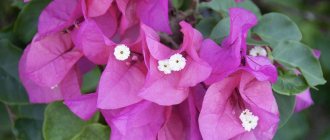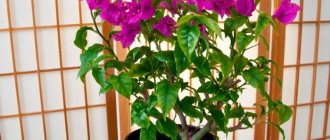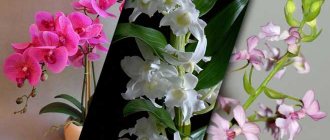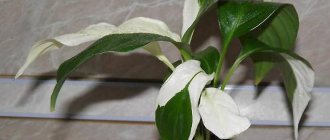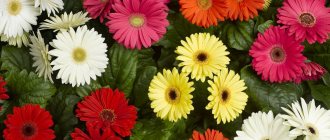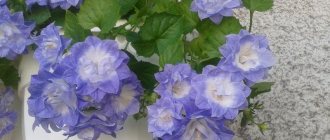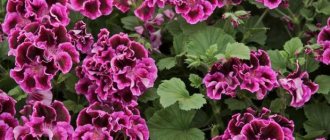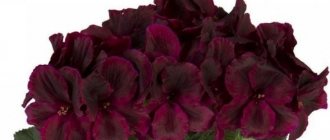Getting to know bougainvillea
Bougainvillea is a tropical plant that is named after the navigator Louis Antoine de Bougainville, who was the leader of a round-the-world expedition with the participation of the famous biologist Kimmerson, and he brought this plant to Europe.
Bougainvillea is native to South America, where it can grow as a vine, small tree or shrub with creeping stems that cling to the surface.
The shoots have spines with which they hold onto supports. Characterized by rapid growth. The average shoot length is about 5 meters. Under our climatic conditions, bougainvillea can only be grown at home or in heated greenhouses. The plant has rounded green leaves with sharp ends up to 8 cm long. The flowers are tubular, light yellow, small in size, and inconspicuous in appearance. The aesthetic appearance of the bush is achieved thanks to the bracts, which have a colorful appearance and a colorful paper texture. They can have different shapes and colors. The shape can be round, triangular or heart-shaped. The length varies from three to five centimeters. The color can be lilac, snow-white, lilac, orange, bright red or pink. Newly introduced bougainvillea varieties may have purple or bicolor bracts that change over time.
Despite the inconspicuous appearance and rapid fading of the flowers, the bracts decorate the plant for a long time. When growing bougainvillea indoors, flowering begins in May and continues until November.
Pruning after flowering
In the fall, after flowering, Bougainvillea also needs to be pruned. When the bracts lose their decorative effect, its young shoots are shortened by a third of their length, leaving 6–8 buds on each. Excess young shoots that spoil the appearance are cut out to the trunk. It is better not to touch old branches, three years old or more - there will be no great effect, and the injury to the plant will be noticeable.
At the same time, before the onset of the dormant period, Bougainvillea is given the desired shape. You can form a flower in the form of a multi-stemmed bush. You can leave the shoots in the form of vines so that on the support you can give them any fancy shapes, for example, in the form of a heart or a ring. No less interesting are the compositions where Bougainvillea branches entwine figured frames, trellises and decorative latticework.
We draw your attention to the fact that during pruning it is necessary to leave a sufficient number of buds of the current year's young shoots, since dormant buds on old shoots awaken with difficulty, and you may be left without new shoots.
Bougainvillea is winter-hardy and can withstand any type of pruning. When pruning bougainvillea, you can shape it into a variety of shapes. Trim the lower branches to give it an interesting tree-like appearance.
Planting bougainvillea at home
Bushes should be planted in pots up to 5 liters. The larger the volume of the pot, the worse the flowering, since indoor bougainvillea begins to actively form leaves without forming buds. The soil for planting can be prepared independently or purchased at garden stores. To prepare the soil, mix coarse sand, leaf soil and turf in equal proportions, add a little expanded clay or broken brick. The soil must be nutritious and moisture-absorbing. The acidity is neutral or weak. A prerequisite for planting is to place a drainage layer at the bottom of the pot. The larger the volume of the container, the thicker the drainage layer should be.
Possible problems during cultivation
Why doesn't bougainvillea bloom at home? The reason may be low temperature and lack of sunlight.
Replanting bougainvillea
It is best to replant bougainvillea at home using the transshipment method. Its roots are very delicate and brittle, and if they are damaged, the plant’s leaves and bracts will begin to fall off, and the cuttings may die. If you water the bush in advance, it will be easier to free the earthen ball from the old container. Growing a vine in a pot that is too large increases the risk of flooding and negatively affects its growth and flowering. If an adult plant requires replanting, the new container should be 2-3 cm wider than the previous one. For the cutting you need to take a small glass, slightly larger than the volume of the root system.
Advice A tight pot has a positive effect on the flowering of vines at home
. When replanting, it is undesirable to bury the root collar - it may rot. Young bougainvilleas are replanted every spring, adults - once every 3-4 years. If the plant is in transport soil, it needs to be shaken off a little, being careful not to damage the roots. It happens that young bushes or rooted cuttings are in a net that remains from peat tablets - it must be removed. You need to put a thick layer of drainage on the bottom of the container; it is advisable to use polystyrene foam for this purpose, but expanded clay will also work. The substrate is nutritious; you can make it yourself by mixing equal parts of sand, vermiculite, turf and leaf soil. Bougainvillea loves a neutral or slightly acidic substrate, with a pH of 6.8-7. You can add a few granules of superphosphate to it. The next feeding is no earlier than 3 weeks after transplantation. If turgor is lost, you can spray the vine with a growth stimulator and cover it with a bag for 2-3 days, periodically removing it for a few minutes.
Growing and caring for bougainvillea
Bougainvillea belongs to the Radiaceae family and has a total of 15 varieties, but only a few of them can be grown at home. Among them are bougainvillea glabra and bougainvillea remarkable. Since it is a tropical plant, it is grown in well-lit areas with plenty of open space. It is quite difficult to get beautiful bougainvillea at home, since it needs to be grown at a certain humidity and air temperature. In greenhouses, the tree is grown in large containers placed on the south side. Bougainvillea is best grown at home on glazed balconies, where the temperature can be maintained within 10 degrees in winter.
Indoors, choose a place where your indoor bougainvillea will receive sunbathing for at least five hours. This is one of the most necessary conditions for normal flowering and growth of the bush. If the pot with it is in a shaded place and receives insufficient light, its shoots grow thin and long, the leaves are pale, and flowering rarely occurs. It should also be taken into account that the tree is afraid of drafts and cold air currents. In summer, you can place pots with plants on an open balcony, protected from the wind.
Bougainvillea is fertilized once every two weeks, alternating mineral fertilizers with organic ones. During the period of active vegetative growth, which begins in May, the flower is fertilized with phosphorus-potassium fertilizers. In winter, the plant is not fertilized or sprayed.
Much attention should be paid to watering the flower. In summer, this is done once or twice a week, when the top layer of soil has dried to the thickness of half a phalanx of a finger. The pot must have a drainage layer, as the plant is sensitive to stagnation of water. The water that collects in the pan after moistening must be drained, as it provokes rotting of the roots and death of the plant.
In winter, indoor bougainvillea is watered once every two weeks. The lower the temperature in the room, the less often you water.
Bougainvillea: care at home
Reviews from gardeners show that a plant of a certain variety requires special conditions. In fact, bougainvillea belongs to the family Nyctaginaceae or Nociformaceae. This genus is represented by only 15, and judging by some sources – 18 species. However, only a few can be grown indoors. First of all, this is bougainvillea naked and bougainvillea is wonderful. Such varieties were obtained as a result of the painstaking work of many breeders. Some of the species are distinguished by decorative bracts, as well as variegated leaves.
Replanting bougainvillea
Transplantation is done once every 5 years to rejuvenate old bushes and once every 2 years to activate growth in young bushes. This procedure is carried out in the spring before flowering begins. When transplanting, transfer the root system along with a lump of earth into a larger pot. Two fingers should be placed between the edge of the earthen ball and the wall of the new pot. The empty space is filled with fresh soil mixture.
Bougainvillea slowly gets used to its new location at home, so moving it from place to place is not recommended. In this case, it can throw off buds and leaves.
But if the growing conditions in the new mass are better, it grows new green mass and after some time begins to bloom profusely. The active growing season occurs in spring and autumn. During this period, the temperature in the room should be around 22-25 degrees. It is recommended to moisten the leaves from the sprayer with sifted soft water so that it does not fall on the bracts.
Keeping bougainvillea in winter
In winter, bougainvillea requires special care. This is due to the fact that the duration of daylight hours decreases sharply and the plant begins to feel a lack of lighting. In winter, indoor bougainvillea needs to create rest. Move the bougainvillea pot to a well-lit, cool place with a temperature of about 5-10 degrees and stop watering. At temperatures above this, the plant will not go dormant, but will continue to grow and bloom. However, this will greatly deplete it and make it weak, which will negatively affect flowering in the spring. With the onset of warmth and increasing daylight hours, the temperature of the room is gradually increased, and watering is done more often.
Bougainvillea - home care
Bougainvillea is a flower that is not particularly common in the collections of amateur gardeners. This plant is considered capricious and difficult to care for. But all this is idle speculation. Caring for bougainvillea at home is not as difficult as it is described. Of course, if you do nothing to create optimal growing conditions for it, then nothing good will come of it.
A little about the plant
Bougainvillea is native to South America. The bougainvillea genus includes only 14 species (according to other sources - 18). Among them are trees, shrubs, and vines. In open ground, it grows in our area, but only in the south. On the South Coast, bougainvillea can be found everywhere. This plant is evergreen and, depending on the species, can have either pubescent or smooth leaves. As strange as it may sound, bougainvillea blooms with small and inconspicuous flowers. But there is nothing strange. What are perceived as luxurious large flowers are actually bracts. In nature, such flowering can continue throughout the year. But at home, bougainvillea requires time for a dormant period. When kept in a greenhouse, it may not be particularly long, and the plant will be able to please you with this peculiar flowering more than once a year.
Propagation of bougainvillea at home
Bougainvillea can be propagated in two ways: cuttings or layering.
- Propagation by cuttings. If you want to carry out cuttings in the spring, cuttings taken from the tops of branches after cutting are suitable for this. They should be cut into ten-centimeter pieces. In summer, cuttings are cut separately. In such a way that the lower cut is as low as possible under the lower bud. The leaves are torn off to the middle. The cuttings are placed in a solution with a rooting agent for several hours. The pots are filled with finely chopped sphagnum moss, coal and sand. The cuttings are placed in this substrate up to the second internode at an angle of 45 degrees, covered with film or placed in a greenhouse, creating a temperature for rooting of 21-23 degrees. During the rooting process, high humidity, diffused light and average soil moisture should be maintained. The seedlings are periodically sprayed and ventilated.
- Reproduction by layering. This method is most often used in greenhouses on plants with large pots. Long stems are cut in a circle and pressed to the ground with wire or wooden brackets, covered with a layer of fertile soil on top and moistened. After some time, new stems emerge from the axillary buds, which develop an independent root system. After the shoot becomes strong, it is cut off from the mother plant with pruning shears and planted in a permanent place.
Pruning and shaping the crown of indoor bougainvillea
When growing bougainvillea at home, you should prune it every year. This will contribute to the preservation of the decorative appearance, the formation of the bush and greater formation of flower ovaries. The procedure is done in autumn or winter. The stems are cut to half, thus activating the growth of side shoots. Some gardeners prune indoor bougainvillea in the spring. This promotes the development of a dense bush and the removal of crooked, diseased, thin and unnecessary shoots. In summer, pruning is carried out after the flowering period. This stimulates the re-formation of flower ovaries. It is not recommended to prune three or four year old branches. Some varieties of bougainvillea can be formed into various shapes by tying shoots to special supports of different configurations: an arch, a ball or a heart. Pruning is an important step in bougainvillea care.
Bougainvillea varieties
There are 14 species of bougainvillea in nature, but gardeners cultivate only two of them:
- Bougainvillea is naked. This is a vine-like plant with glossy round leaves and thorns on the shoots. The bracts are white, bright red, purple or pink and have small yellow flowers that are located on them. The flowering period begins in April and lasts for a month. Under natural conditions, vine shoots can be up to 6 meters long, but in greenhouses and home cultivation their length does not exceed three meters.
- Bougainvillea is beautiful . A fast growing plant with velvety oval leaves. The flowers are collected in paniculate inflorescences of two or three, located on bright bracts of pink-green, pink-violet or red. The central stem can grow up to 15 m in length.
In addition to these two species, there are a huge number of different innovative varieties that differ in the color of their bracts. It can be bright orange, coral, crimson, pink, rich yellow, snow white, purple, ruby red and other colors.
Types and varieties
The bougainvillea genus is small; it includes only 14 plant species. Popular varieties for growing in the garden and at home:
- Bougainvillea is naked. The variety got its name due to the absence of thorns on the stem. During the flowering period, and in the southern regions it lasts up to 9 months, the plant produces small golden flowers surrounded by crimson bracts. They can grow both around the flower and around the entire inflorescence.
- Bougainvillea is beautiful. Long curving shoots are covered with dark velvety leaves. During the flowering period, the shrub is covered with a cap of numerous snow-white flowers.
- Bougainvillea peruviana. The variety differs from others in that it does not produce side shoots. The branches are covered with narrow long leaves with thorns at the base. Multi-flowered Peruvian bougainvillea has double stipules with a slightly wrinkled surface.

